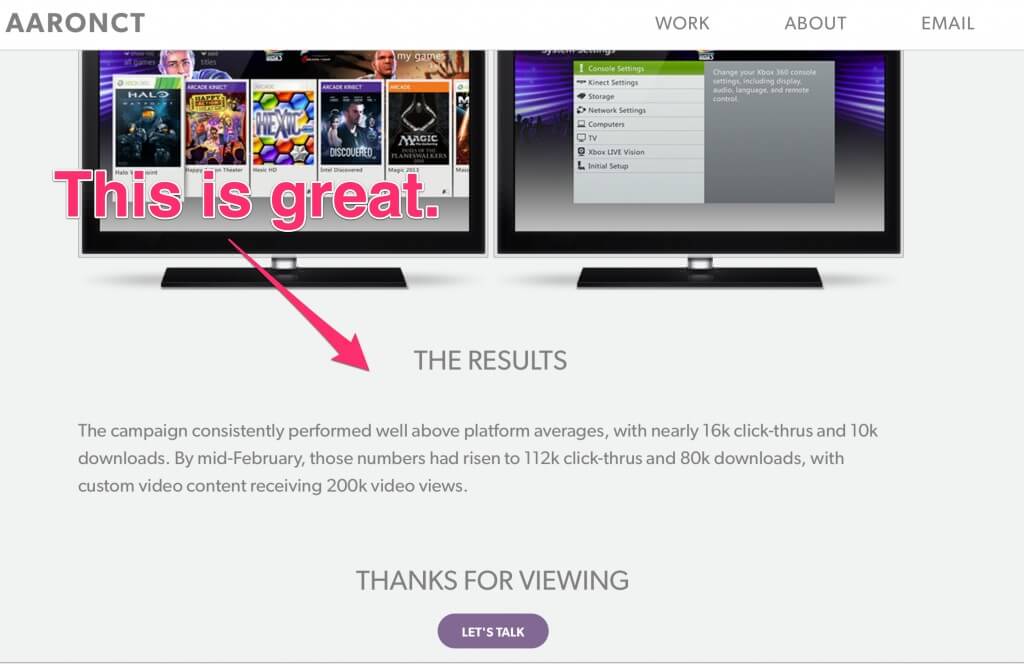Ben writes in from the Philippines,
“My biggest problem in freelancing (mine is web development) is not having enough ”good“ portfolio to show prospective clients. Do I really need to have one? I want to start all over again as a freelancer. Do I need to have portfolio pieces before I can start making my freelancing as a real business?”
I remember when I first started out as a freelancer, I knew I had to have a portfolio on my site. Why? Well… everyone else had one — that’s why.
So I did what most of us end up doing: I grabbed screenshots of a few sites I had worked out, and laid them out in a nice little table and stuck it front and center on my shiny new sales website.
It can’t hurt to show that you’ve been hired and produced something in the past. But the way we do demonstrate the fact that we’re capable of Getting Stuff Done could be done a lot better. On top of this, it makes sense to try to figure out why clients might care about a portfolio, and to use that to our advantage.
So here’s a bit about why clients care about portfolios, and what that means to you.
Why Clients Care About The Work You’ve Done
You’ve probably heard me talk in the past about how risk typically dominates the hiring decision. When a client feels that someone is particularly high risk (“Do they know what they’re doing?”, “Do they understand what I need?”, “Are they reliable enough to get this done?”) the default position is to put less money on the table — if the project goes bellyup, the client would rather have wagered less money.
So the obvious converse is that if you can prove that you are a very safe bet, and that hiring you will almost certainly yield the business results they’re looking for, pockets will deepen. I’ve talked about various ways of doing this (understanding the problem behind the project, identifying the financial upside of a project, etc.)
The idea is that if you’ve been hired before and have done good work, you’re less likely to flake out. After all, presumably, someone paid you a good deal of money for that website you link to in your portfolio. And it seems to still be running, and it looks pretty good, so at least you’re less likely to disappear with the clients’ cash and not deliver anything in return.
In my experience running an agency and having hired dozens of freelancers myself I’ve seen first-hand that the reason porfolios matter isn’t as much to see how many projects you’ve worked on or what sort of industries you’ve catered to. Instead, it’s to overcome an internal objection every client asks themselves: “How likely is it that this will get done?”
The Dos and Don’ts of Portfolios
Most portfolios are simply a list of websites or companies. Web designers often include thumbnails of the sites they’ve designed, and display them in a grid of sorts.
The problem with doing this is the lack of context:
- Why did you work on this project?
- What made somebody spend thousands of dollars on it with you?
- What problems did you have to solve?
- What was the effect on the client’s business as a result of this project?
As a potential client, I want to know that if I spend money on you, I’ll make a return on that investment. That’s almost always the primary goal — everything else is secondary. So just linking to a pretty website isn’t going to answer that question.
I want to imagine myself in your past clients’ shoes. I want to know how other people have spent money on you, what magic you worked, and how insanely successful those past clients of yours now are.
This is why I’ll end up hiring you, even if you’re twice the cost of somebody who gives me zero confidence in their ability to print money for me.
So your portfolio should be less of a list of past clients, and instead stories — case studies that state: “I was approached with X problem, I did Y, and Z is what this client’s business looks like because of my work.”
Your client probably won’t always be comfortable with letting you share a detailed version of “Z” — financial metrics are usually buried behind a non-disclosure agreement. However, when soliciting the testimonials that you’ll want to include in your case studies, make sure that the questions you ask that prompt your testimonial are aimed at, “How have I made your business better?”
Check out the success stories on my website. None of the testimonials say, “Brennan is awesome to work with!” Instead, the testimonials I’ve gathered are focused on how I’ve made people’s businesses better off (and made them more money.) You’ll see a lot of multiples: “I 10xed…”, “the class was worth 20x”… This was intentional, because I want prospective buyers to be able to see that I’m positioning myself as an investment, and not an expense.
(This portfolio simply lists out the company name, website, location, and a screenshot of their past clients. What does this tell me? Nothing.)
(Aaron tells the story of one of his clients. He talks about what led to the project, showcased some gorgeous screenshots that were the fruits of his labor, and finally listed what the net effect was for the client on download count, etc.)
Are Portfolios An Undisputed Requirement?
I don’t think you necessarily need a portfolio. If you’re just starting out, you’re not going to have much of one anyway.
Remember that the goal of a portfolio (or, what I like to call a list of success stories) is to help mitigate the perceived risk of failure. What are some other ways that you could convince a prospective client that you’re reliable?
- You could establish your own authority and expertise by producing great content or hosting seminars.
- You could increase your level of professionalism by coming equipped with a list of questions — ideally focused around them and their business — when meeting with a new client.
- You could become highly active in your local business community and get to know and impress people who will vouch for your reliability.
- Your proposals could focus on the why of a project, and not just the how.
There really is no end to the number of ways that you could stand out against your competition to help decrease the risk a client puts on working with you.
If you do have a portfolio, and it’s either a list of website thumbnails or logos, I’d strongly recommend writing a few case studies and promoting them. You want your future clients to dream; let them put themselves in the shoes of your past clients.

